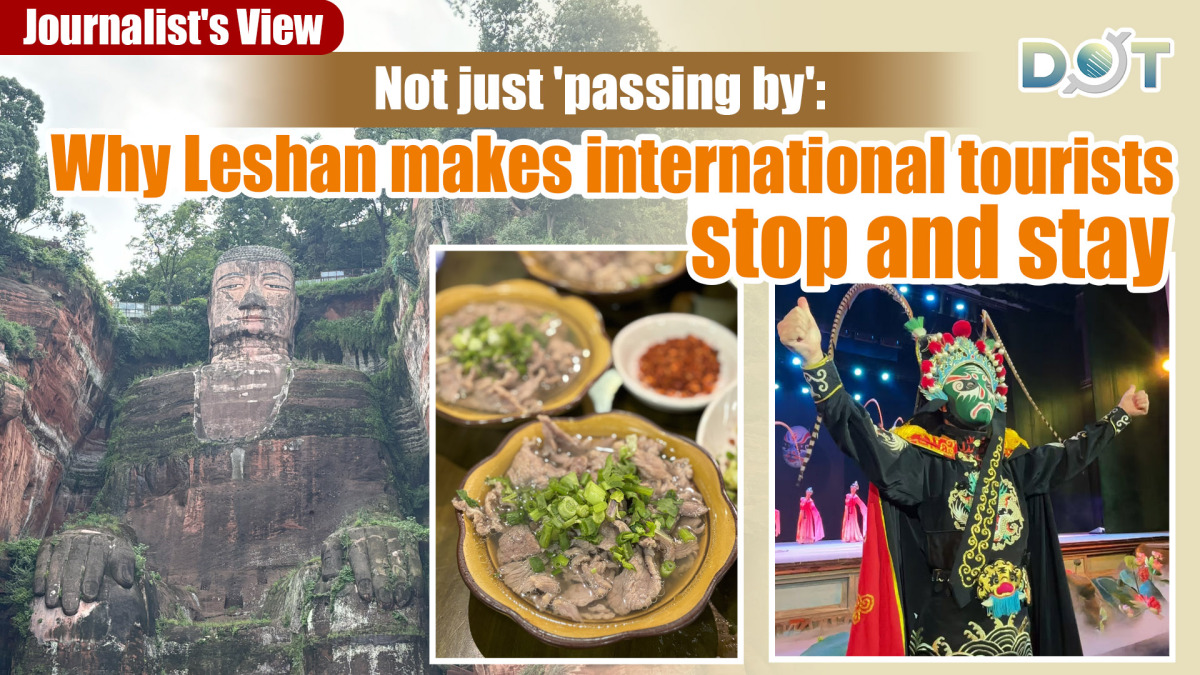
By Zoey SUN
At the Chengdu Research Base of Giant Panda Breeding, a French tourist is intently photographing an adorable panda munching on bamboo. When asked about other destinations in his Sichuan trip itinerary, his answer is immediate: "The Leshan Giant Buddha! I'm eager to see it in person."

This young man's excitement reflects a new trend in Sichuan's tourism market. According to public data, Sichuan welcomed over 2 million inbound tourists in 2024, a 170% year-on-year increase. With the continued optimization of the country's 240-hour visa-free transit policy, the global popularity of cultural icons like Ne Zha, and the lasting impact of the 2025 World Games, the number of inbound foreign tourists to Chengdu reached 69,000 from July 1 to Aug. 15 alone, a 72.5% year-on-year growth. This surge in inbound tourism is now extending along the "Chengdu-Leshan Tourism Corridor," drawing visitors to Leshan—a city boasting three UNESCO World Heritage Sites.
Bridging language barriers: Making nature and culture accessible to the world
Leshan's unparalleled natural scenery and millennia of cultural heritage create a unique draw for international tourists. During this Sichuan trip, DotDotNews reporter joined a tour group to visit the Leshan Giant Buddha and Mount Emei. The Leshan Giant Buddha, carved out of a hillside in the 8th century, is the world's largest stone Buddha statue. Visitors can climb the mountain along the stone steps for a ceremonious, close-up experience of the Buddha, touching the weight of history; or they can take a boat ride to marvel at the confluence of the three rivers while gazing up at the solemn and compassionate Buddha, feeling the harmony of nature and human craftsmanship—"The mountain is a Buddha, and the Buddha is a mountain."


Mount Emei, another UNESCO World Heritage Site, adds a second chapter to this grandeur. As one of China's four sacred Buddhist mountains, its main peak rises 3,099 meters above sea level. Known for its "majestic, graceful, strange, perilous, and secluded" beauty, the mountain boasts stunning natural scenery, profound Buddhist culture, diverse flora and fauna, and distinctive geological formations. When clouds roll in, Mount Emei's Jinding (Golden Summit) is enveloped in thick mist, with the statue of Puxian Bodhisattva appearing ethereal, as if in a fairyland.

DotDotNews reporter also visited other attractions like the Oriental Buddha Park and the Emeishan Giant Buddha Zen Courtyard. Among the tourists, foreign faces could often be seen. A British couple shared that besides the natural beauty of the sites, the internationalization of the destinations significantly enhanced their experience and was a key reason for their visit.
Take the Leshan Giant Buddha Scenic Area as an example. The site has deployed over 50 iFlytek translation devices for real-time multilingual interpretation, introduced self-guided audio tours in seven languages, and launched bilingual Chinese-English tourist maps. Additionally, "one-stop" foreign visitor service stations have been set up to provide translation assistance, emergency coordination, and other services. These measures help break down language barriers, allowing natural and cultural heritage to become a global language that international tourists can "read," "hear," and "understand." In 2024, the Leshan Giant Buddha Scenic Area received 227,000 inbound tourists, a staggering 386.08% year-on-year increase, and welcomed 139,700 overseas visitors in the first half of 2025, up 28.59% year-on-year.
A new path for cultural-tourism integration: From Sightseeing to in-depth experiences
Leshan is exploring innovative ways to integrate culture and tourism by deeply developing cultural experience programs. For instance, the Emei Martial Arts Shrine, located within the Grand Buddha Zen Courtyard, combines traditional architectural style with the temple's solemnity, narrating the long history of Emei martial arts. Originating in Mount Emei and blending Buddhist, Daoist, and Confucian philosophies, Emei martial arts are known for their balance of hardness and softness, unpredictability, and profound cultural and philosophical roots. According to Li Wanfeng, vice president of the Emei Martial Arts Association and an intangible cultural heritage inheritor of Emei martial arts, Emei is one of China's three major martial arts schools and enjoys significant international renown. Every year, many visitors from Hong Kong, Macao, Taiwan, and foreigners from other countries come to learn and experience Emei martial arts.


At the Jinding of Mount Emei, visitors can join Buddhist ceremonies, gaining a unique spiritual experience atop the mountain at over 3,000 meters above sea level. Meanwhile, the Oriental Buddha Park, known as a filming location for the movie Fengyun, draws fans and tourists alike with its awe-inspiring stone-carved grottoes and cinematic fight scenes, achieving a perfect blend of film culture and tourism.

Leshan's rich cultural heritage is not limited to its static UNESCO sites but also comes alive on the stage of intangible cultural heritage performances. In shows like "Sheng Xiang Emei", a Sichuan opera face-changing artist can wow the audience with a single spin or wave of the sleeve as the mask transforms instantly. Fire-spitting performers demonstrate the power of traditional techniques, exhaling fiery "dragons." Meanwhile, life-sized puppets from northern Sichuan, dating back to the Qing Dynasty, captivate audiences with lifelike movements and expressions, recounting the ancient stories of Bashu culture. These dynamic cultural expressions transcend language barriers, allowing international tourists to experience the ingenuity and innovation of Sichuan culture firsthand.


By incorporating these intangible cultural heritage performances into tourism itineraries and international promotional campaigns, Leshan has significantly enhanced its cultural identity on the global stage. As foreign tourists share these thrilling moments on social media, Leshan's cultural image is broadcast worldwide. By creating a "culture + tourism + experience" model, Leshan invites international visitors to become participants and explorers of its culture, extending their stays and enhancing their experiences, thus injecting new vitality into its cultural tourism internationalization.
A universal language: The global appeal of Leshan's culinary delights
As evening falls, Zhanggongqiao Food Street comes alive, its symphony of clanging woks, lively chatter, and sizzling food creating a uniquely vibrant atmosphere.
The saying goes, "To taste Sichuan, savor Leshan." With over 100 varieties of snacks alone, Leshan is a culinary paradise. At the sweet-skinned duck stalls, shiny, caramel-colored ducks are chopped into crispy pieces, releasing the sweet aroma of caramelized glaze into the air. Nearby, cauldrons of Qiaojiao beef (boiled beef with spices) bubble away, their rich broth blending the fragrances of medicinal herbs and beef bones. Stalls selling Bo Bo Chicken (cold slices of chicken served with chili sauce) display skewers soaking in a secret marinade of chili oil and Sichuan pepper, their bright colors and enticing aroma drawing hungry crowds. By combining "gastronomy + cultural tourism," Leshan has created a city charm that is hard to resist. Data shows that Leshan's urban core attracts tens of thousands of visitors each year who come specifically for its culinary delights. Recognizing this, Leshan has proposed creating a "World City of Gastronomy."



To make its cuisine more accessible to international visitors, Leshan has taken steps toward culinary internationalization. The city has worked with foreign affairs departments to standardize English translations for its signature dishes, distributing these translations to local vendors. During the May Day holiday in 2025, over 200 food businesses in Leshan launched bilingual menus, supported by bilingual food maps and recommended food routes. Over the first two days of the holiday, the urban area of Leshan saw a 233% year-on-year increase in inbound tourists, with its distinctive snacks—such as sweet-skinned duck, Bo Bo Chicken, and Dan Hong Gao (egg pancakes)—becoming new symbols of Leshan's international appeal.
Comprehensive preparations: Upgrading policies and services
Leshan has implemented a systematic and comprehensive strategy to welcome the influx of inbound tourists. On the policy front, in 2025, Leshan introduced preferential policies for inbound tourism. For example, Hong Kong, Macao, and Taiwan residents can enjoy a 50% discount on full-price tickets to the Leshan Giant Buddha and Mount Emei Scenic Areas, as well as discounts on hotels, homestays, and high-speed rail tickets.
In terms of facilities and services, the city has added over 2,000 POS machines and 550 ATMs capable of handling foreign cards in hotels, scenic spots, resorts, and shopping areas. Key attractions are equipped with translation devices, self-guided tours in seven languages, and bilingual maps. Even the public security and traffic departments have launched specialized foreign language training programs, making bilingual services a "new standard" for Leshan police officers. At Mount Emei, the efficiency of foreign-language traffic consultations has increased by 50%. Leshan also plans to expand English training for frontline tourism workers to further improve its international service standards.

Despite these efforts, challenges remain. Most foreign tourists still treat Leshan as a day-trip destination, and extending their stays is a critical task. To achieve this, Leshan could develop more in-depth cultural experience products, such as Buddhist meditation, cooking classes, and hands-on intangible cultural heritage workshops, encouraging international tourists to shift from sightseeing to immersive experiences.
Today, Leshan's internationalization efforts are steadily advancing through meticulous attention to detail. The city not only showcases its rich history but also embraces an open and forward-looking attitude toward the world. Every thoughtful preparation builds a deeper connection between Leshan and international tourists. As more visitors slow down to stay, experience, and explore Leshan, the city's vision of becoming a global tourism destination will come closer to reality.
Related News:




















Comment